Body length: 4–14 mm.
Eyes: eye interommatidial setaeseta:
a sclerotized hair-like projection of the cuticle
absent, eye deeply emarginateemarginate:
notched at the margin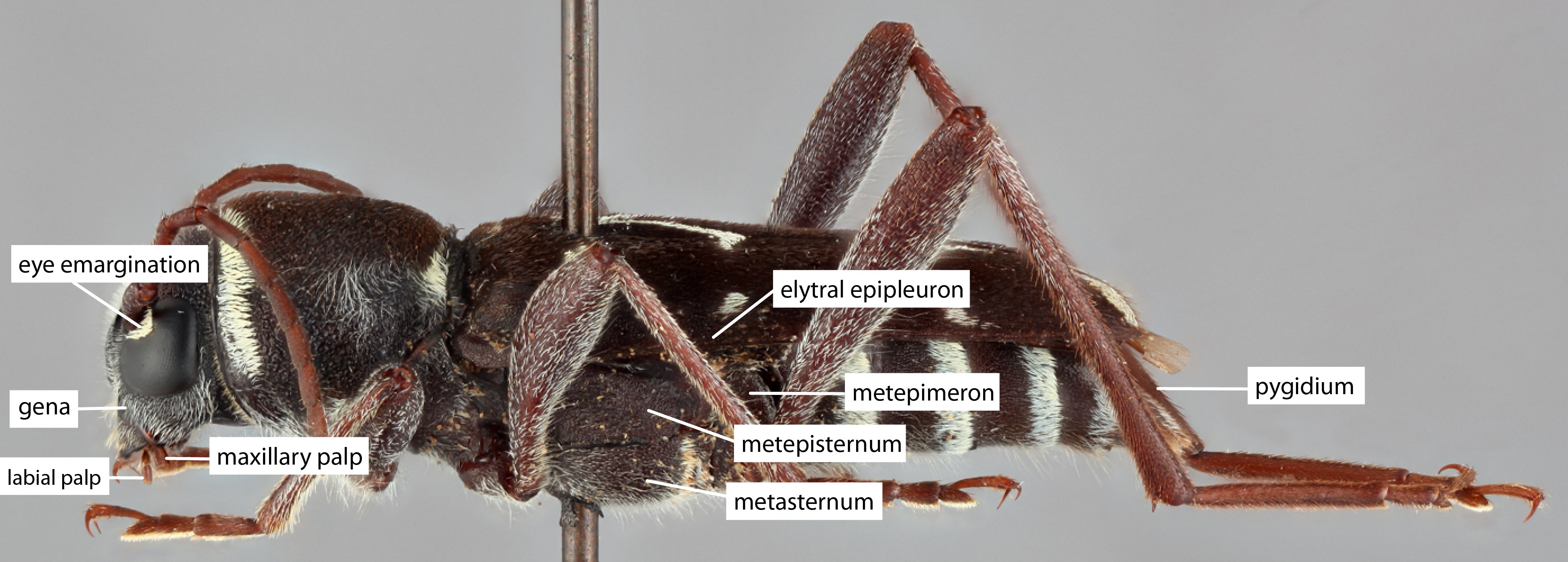 > half width, eye ommatidial density coarse.
> half width, eye ommatidial density coarse.
Antennaeantenna:
in larval and adult insects, paired segmented appendages, borne one on each side of the head, functioning as sense organs and bearing a large number of sensilla
: antennal length reaches between basebase:
the part of any appendage or structure that is nearest the body
and end of elytraelytron:
the leathery forewing of beetles, serving as a covering for the hind wings, commonly meeting opposite elytron in a straight line down the middle of the dorsum in repose
or reaching/surpassing end of body, antennal flagellar segments elongateelongate:
much longer than wide
, scapescape:
the first proximal segment of the antenna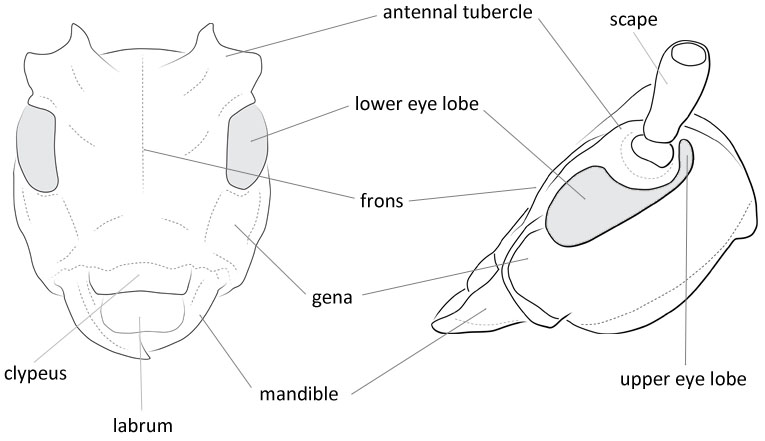 smooth/punctate at apexapex:
smooth/punctate at apexapex:
end of any structure distad to the base
, antennal segment 3 > scapescape:
the first proximal segment of the antenna , rarely scapescape:
, rarely scapescape:
the first proximal segment of the antenna ≥ segment 3.
≥ segment 3.
Pronotumpronotum:
the upper and dorsal part of the prothorax
: pronotumpronotum:
the upper and dorsal part of the prothorax
shape transversetransverse:
broader than long
, pronotumpronotum:
the upper and dorsal part of the prothorax
lateral armature blunt tubercule.
Prosternum: prosternal processprosternal process:
a posterior extension of the prosternum between the coxae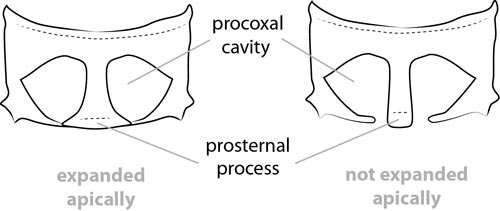 dilated at apexapex:
dilated at apexapex:
end of any structure distad to the base
, procoxal cavities closed posteriorly.
Elytraelytron:
the leathery forewing of beetles, serving as a covering for the hind wings, commonly meeting opposite elytron in a straight line down the middle of the dorsum in repose
: elytral length reaching or close to end of abdomen, elytral apicesapex:
end of any structure distad to the base
rounded or truncatetruncate:
cut off squarely at the tip
, elytral color pattern present.
Legs: visible tarsomerestarsomere:
subdivision or article of the tarsus, usually numbering from two to five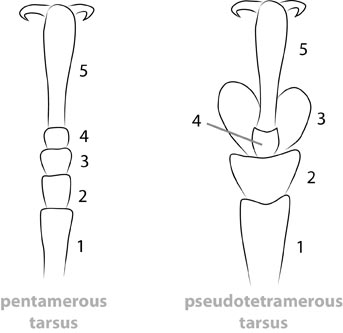 : 4, femora clavateclavate:
: 4, femora clavateclavate:
thickening gradually toward the tip
, protibial spursprotibial spur:
sclerotized spine(s) located at the distal tibia; can be single, double, or absent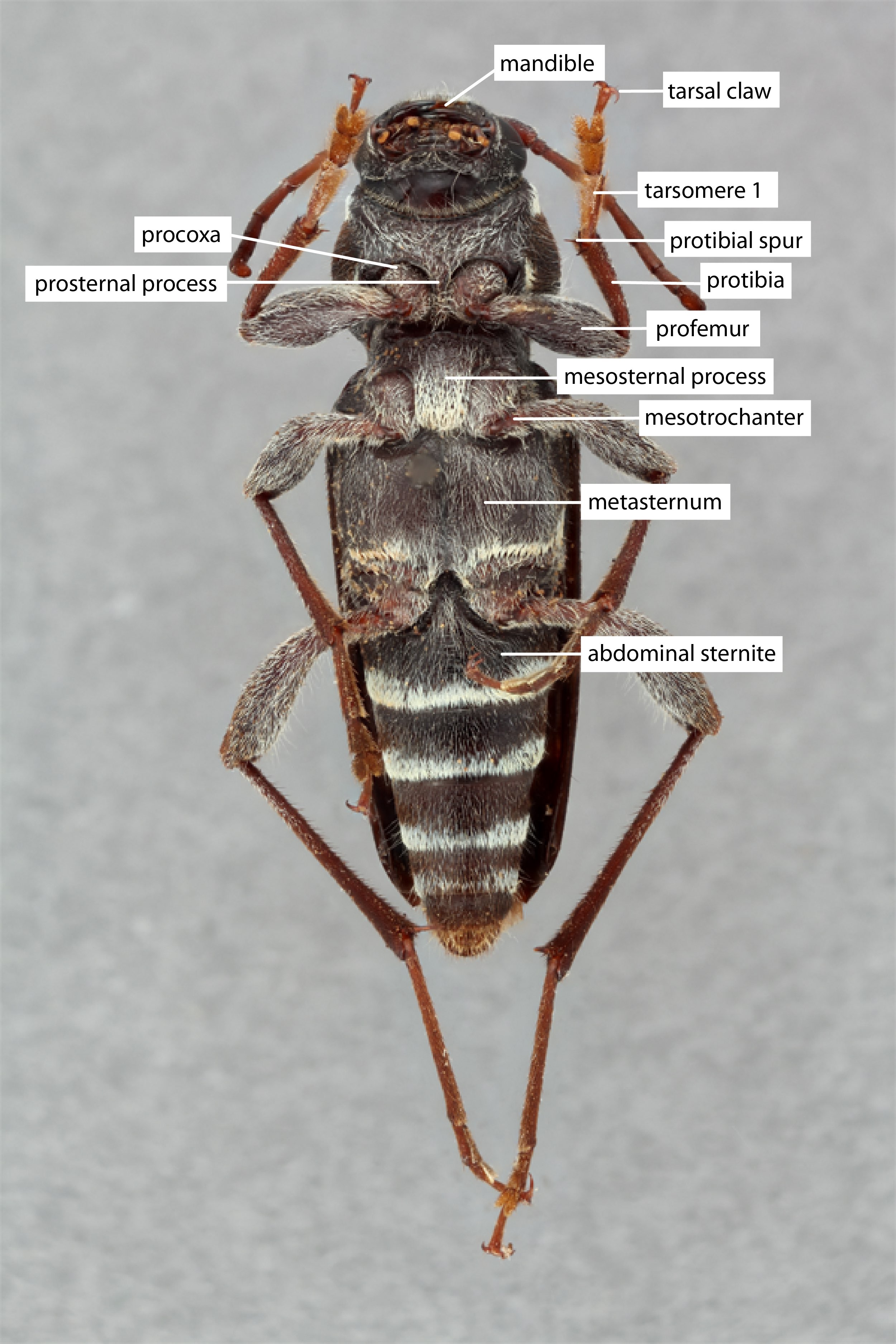 : 2, tarsal clawstarsal claw:
: 2, tarsal clawstarsal claw:
usually paired claws of the pretarsus, at the distal end of the leg simple.
simple.
Form moderate-sized, convex. Head with front almost plane, about as broad as long; mandibles feebly arcuatearcuate:
arched or bow-like
; genaegena:
the part of the cranium on each side below the eye slightly convergent, as long as lower eye lobes; eyes moderate-sized, deeply emarginateemarginate:
slightly convergent, as long as lower eye lobes; eyes moderate-sized, deeply emarginateemarginate:
notched at the margin , upper lobes small, well separated above; antennal tubercles prominent, widely divergentdivergent:
, upper lobes small, well separated above; antennal tubercles prominent, widely divergentdivergent:
spreading out from a common base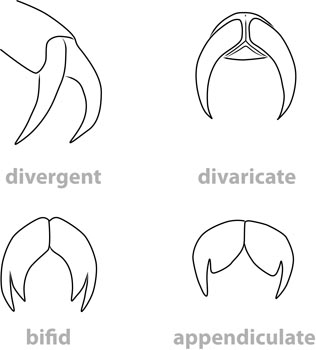 ; antennaeantenna:
; antennaeantenna:
in larval and adult insects, paired segmented appendages, borne one on each side of the head, functioning as sense organs and bearing a large number of sensilla
eleven-segmented, a little longer than body in males, segments from fifth short, scapescape:
the first proximal segment of the antenna with two setaeseta:
with two setaeseta:
a sclerotized hair-like projection of the cuticle
beneath near apexapex:
end of any structure distad to the base
, third segment longer than scapescape:
the first proximal segment of the antenna , fourth shorter than third, shorter than or equal to scapescape:
, fourth shorter than third, shorter than or equal to scapescape:
the first proximal segment of the antenna . Pronotumpronotum:
. Pronotumpronotum:
the upper and dorsal part of the prothorax
broader than long, sides with obtuse tubercles just behind middle; disk with five prominent calluses, median basal one largest, two vague calluses present at sides above lateral pair; basebase:
the part of any appendage or structure that is nearest the body
and apexapex:
end of any structure distad to the base
rather broadly impressed; prosternum narrow, intercoxal process lightly arcuatearcuate:
arched or bow-like
, more than 1-1/2 as broad as coxal cavities; mesosternummesosternum:
sternum of the mesothorax
with intercoxal process abruptly declivous anteriorly, as broad as coxal cavities; metasternum with episternumepisternum:
the aspect of a thoracic pleuron dorsal to the coxal cavity and anterior to the pleural suture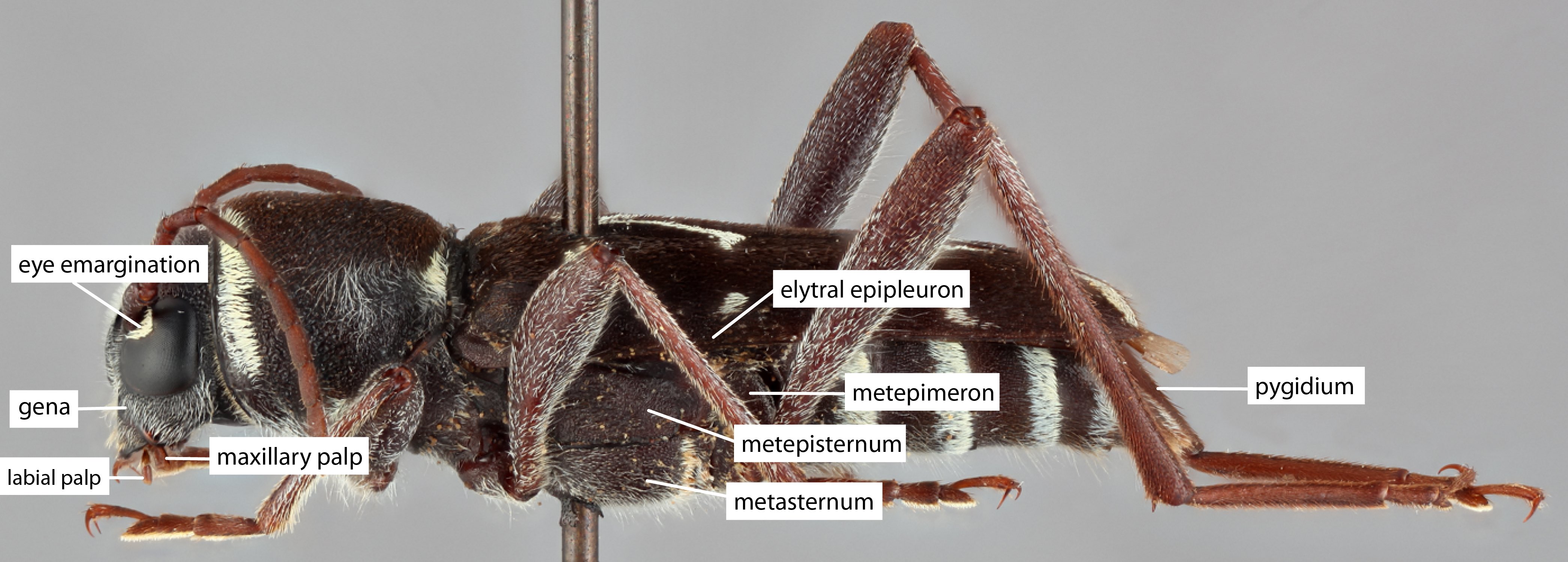 narrow, sub parallel. Elytraelytron:
narrow, sub parallel. Elytraelytron:
the leathery forewing of beetles, serving as a covering for the hind wings, commonly meeting opposite elytron in a straight line down the middle of the dorsum in repose
about twice as long as broad, strongly convex; basal gibbosities prominent, broad; disk costate, costae with rows of pubescentpubescent:
downy; clothed with soft, short, fine, loosely set hair
tufts, erect setaeseta:
a sclerotized hair-like projection of the cuticle
absent; apicesapex:
end of any structure distad to the base
narrowly, obliquely truncatetruncate:
cut off squarely at the tip
to rounded. Legs stout; femora pedunculate; tarsitarsus:
the leg segment distal to the apex of the tibia, bearing the pretarsus; consists of one to five tarsomeres (including pretarsus)
short, stout, first segment shorter than two following segments together. Abdomen normally segmented, last sternite longer than preceding segments (Linsley and Chemsak 1995Linsley and Chemsak 1995:
Linsley EG and Chemsak JA. 1995. The Cerambycidae of North America. Part VII, No. 2. Taxonomy and Classification of the Subfamily Lamiinae, Tribes Acanthocinini Through Hemilophini. University of California Press, Berkeley and Los Angeles. 292 pp.).
Astylopsis, Lagocheirus, Leptostylopsis, Styloleptus, Astylidius, Pseudastylopsis
The smaller size, pronotumpronotum:
the upper and dorsal part of the prothorax
with five prominent dorsal tubercles, mesosternal processmesosternal process:
a prolongation of the mesosternum extending between the mesocoxae
equal to the width of the coxal cavities, and tufted tubercles on the elytraelytron:
the leathery forewing of beetles, serving as a covering for the hind wings, commonly meeting opposite elytron in a straight line down the middle of the dorsum in repose
will distinguish Leptostylus among similar genera.
Nearctic, Neotropical
broadleaf trees
87 species and an additional subspecies
Amniscus Haldeman, 1847 [part]
Leptostylus LeConte, 1852